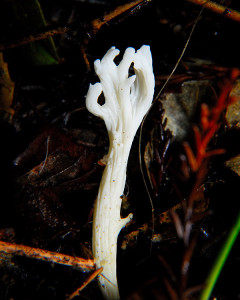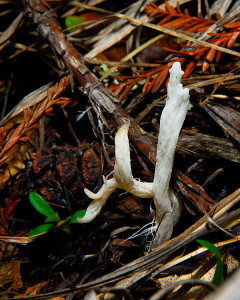Continuing our foray into the fascinating field of fungi we’re moving on, from the waxy cap mushrooms, to some species of club and coral fungi.
The first fungus we encountered on our walk this past weekend was Clavulina rugosa. It was lurking just downhill of the redwood grove on the north side of the vegetable gardens, alongside an old downed madrone. The madrone itself was covered in a different species of fungus (as yet unidentified), so at first we didn’t notice this diminutive specimen. Throughout our hike around the property, despite close scrutiny of the forest floor, these were the only specimens of this particular fungus we found.
Clavulina rugosa is a member of the club fungus group. In fact, fungi in the genus Clavulina get their name from the Latin clava, meaning club.
Clavulina rugosa is presumed to be a mycorrhizal fungus. Mushrooms that are mycorrhizal typically have a symbiotic (mutually beneficial) relationship with other plants, including trees. In such relationships the mushroom is thought to assist the plants in absorbing water and nutrients, and in return, the plant provides nutrients to the fungus.
Clavulina rugosa is found throughout North America, and is commonly found in damp woodlands under conifers and hardwoods. This species usually emerges in summer and fall, but does grow in the winter in warmer climates. Although it may occasionally be found growing in small clusters, it’s not unusual for this fungus to be seen growing alone. Clavulina rugosa averages 4-12 cm high and a mere 1.5 cm wide. This species is easily recognized by its minimal branching growth habit, that often appears antler-like. As is more clearly seen in the first picture, the surface texture is wrinkled, and the branch tips are generally blunt and laterally compressed.
Tomorrow…a coral fungus that looks more like it belongs in the ocean, not on the forest floor!












They look a bit like pieces of coral from the ocean, don’t they?
They do look very coral like, and in fact some mycology texts do lump the Clavulinas in with other coral fungi. The Ramaria’s I’ll post tomorrow though are even more coral-like!
I love the first pic. It looks very coral like. I was surprised to learn the coral one is still to come.
These have been really interesting, and great pictures!
Fungi just fascinates me.